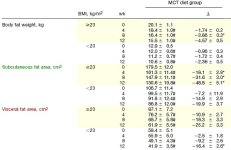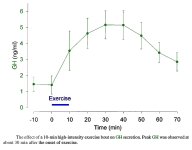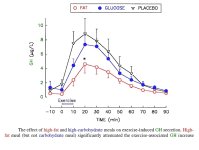You are using an out of date browser. It may not display this or other websites correctly.
You should upgrade or use an alternative browser.
You should upgrade or use an alternative browser.
Dat's - CJC-1295 & GHRP-6 (Basic Guides)
- Thread starter DatBtrue
- Start date
- Joined
- Jul 25, 2008
- Messages
- 1,700
Wow thanks for posting. Any suggestions for dosing the MCT's?
No mega-doses. A serving is about 18 grams. While a spoonful is 6 grams. Three servings is 54 grams. Just replace some of your daily intake of fats w/ MCT oil.
Dietary Medium-Chain Triacylglycerols Suppress Accumulation of Body Fat in a Double-Blind, Controlled Trial in Healthy Men and Women, Hiroaki Tsuji, Human Nutrition and Metabolism, The Journal of Nutrition 131: 2853–2859, 2001
ABSTRACT:
We investigated the effect of long-term ingestion of dietary medium-chain triacylglycerols (MCT) on body weight and fat in humans. Using a double-blind, controlled protocol, we assessed the potential health benefits of MCT compared with long-chain triacylglycerols (LCT) in 78 healthy men and women [body mass index (BMI) >= 23 kg/m2: n = 26 (MCT), n = 30 (LCT); BMI <= 23 kg/m2: n = 15 (MCT), n = 7 (LCT)]. Changes in anthropometric variables, body weight and body fat during the 12-wk MCT treatment period were compared with those in subjects consuming the LCT diet.
The subjects were asked to consume 9218 kJ/d and 60 g/d of total fat. The energy, fat, protein and carbohydrate intakes did not differ significantly between the groups.
Body weight and body fat in both groups had decreased by wk 4, 8 and 12 of the study. However, in the subjects with BMI >= 23 kg/m2, the extent of the decrease in body weight was significantly greater in the MCT group than in the LCT group. In subjects with BMI >= 23 kg/m2, the loss of body fat in the MCT group (-3.86 +- 0.3 kg) was significantly greater than that in the LCT group (-2.75 +- 0.2 kg) at 8 wk.
In addition, in subjects with BMI >= 23 kg/m2, the decrease in the area of subcutaneous fat in the MCT group was significantly greater than that in the LCT group at wk 4, 8 and 12. These results suggest that the MCT diet may reduce body weight and fat in individuals (BMI >= 23 kg/m2) more than the LCT diet.
ABSTRACT:
We investigated the effect of long-term ingestion of dietary medium-chain triacylglycerols (MCT) on body weight and fat in humans. Using a double-blind, controlled protocol, we assessed the potential health benefits of MCT compared with long-chain triacylglycerols (LCT) in 78 healthy men and women [body mass index (BMI) >= 23 kg/m2: n = 26 (MCT), n = 30 (LCT); BMI <= 23 kg/m2: n = 15 (MCT), n = 7 (LCT)]. Changes in anthropometric variables, body weight and body fat during the 12-wk MCT treatment period were compared with those in subjects consuming the LCT diet.
The subjects were asked to consume 9218 kJ/d and 60 g/d of total fat. The energy, fat, protein and carbohydrate intakes did not differ significantly between the groups.
Body weight and body fat in both groups had decreased by wk 4, 8 and 12 of the study. However, in the subjects with BMI >= 23 kg/m2, the extent of the decrease in body weight was significantly greater in the MCT group than in the LCT group. In subjects with BMI >= 23 kg/m2, the loss of body fat in the MCT group (-3.86 +- 0.3 kg) was significantly greater than that in the LCT group (-2.75 +- 0.2 kg) at 8 wk.
In addition, in subjects with BMI >= 23 kg/m2, the decrease in the area of subcutaneous fat in the MCT group was significantly greater than that in the LCT group at wk 4, 8 and 12. These results suggest that the MCT diet may reduce body weight and fat in individuals (BMI >= 23 kg/m2) more than the LCT diet.
NOTE: That those in the high body mass index group lose more subcutaneous fat then the lower body mass group BUT they both lose substantial visceral fat. Visceral fatloss is what we would expect given the previous posted study.
- Joined
- Jul 25, 2008
- Messages
- 1,700
Is red palm oil a good equivalent to coconut oil? I get bored with coconut oil's taste after a while
MCT oil is basically (66-75%) Caprylic Acid & the remainder Capric Acid.
Caprylic Acid has 8 carbons.
Capric Acid has 10 carbons
Coconut oil contains these MCTs however the primary constituent in coconut oil & palm kernel oil is lauric acid.
NOTE: Although Palm Kernel oil contains half lauric acid, the other half is long-chain oils. Further note that Palm oil (as opposed to the kernel oil) has no MCTs or Lauric acid.
Lauric acid has a lot of wonderful qualities (activates thyoid hormone & raises metabolism) but it is 12 carbons long and that may be too long to have the same effect as the shorter chains.
"Activated medium-chain fatty acids (C8 and C10) freely diffuse into mitochondria to be oxidized but long chain fatty acids do not diffuse into mitochondria so they must be transported in."
See below, the pathway the MCTs (designated MCFAs) take as opposed to needing to be transported inward.

The oxidation of fatty acids is an important source of energy for ATP production in mitochondria through the entry of acetyl-CoA into the Krebs cycle. Fatty acids are oxidized inside the mitochondrial matrix but the fatty acids to be oxidized come from the cytosol. Fatty acids are activated in the cytosol by esterification with Coenzyme A (CoA) to form acyl-CoA (RCO-CoA, where R is the fatty acid acyl group). Activated medium-chain fatty acids (C8 and C10) freely diffuse into mitochondria to be oxidized but long chain fatty acids do not diffuse into mitochondria so they must be transported in. The transport of long chain fatty acids into mitochondria for oxidation is accomplished by the carnitine palmitoyltransferase system (CPTI and CPTII). CPTI exchanges carnitine for the CoA attached to long chain fatty acids to form a fatty acid-carnitine conjugate (RCO-carnitine). The fatty acid-carnitine is transported into the matrix by a transporter protein in the inner mitochondrial membrane. Once the fatty acid-carnitine is inside the matrix, CPTII exchanges CoA for carnitine to produce fatty acid-CoA once again, ready to enter fatty acid oxidation in the matrix to produce energy. The free carnitine is transported back out to renew the cytoplasmic pool of carnitine and allow the transfer process to continue.
- Joined
- Jan 21, 2009
- Messages
- 648
Thank you for posting that up BT. MCTs, specifically caprylic acid (octonate) does much more than that. Permit me to introduce you to one of my secrets.
You are so welcome! You secrets is why most o fus are here.
Medium-chain fatty acids (MCFA) belong to a unique type of fatty acids that is metabolized differently from either long-chain fatty acids or carbohydrates. Dietary Medium-chain triglycerides (MCT) inhibit body fat mass growth in both animals and human.
[The afore-mentioned was presented by you BT & your wonderful illustrations]
I thought you would appreciate those graphics. Good graphics are usually hard to find unless you scan them.
In this work, we provided the first evidence that medium-chain octanoate can be ß-oxidized in adipocytes independent of CPT-I regulation. Hence, supplement of octanoate maintains active ß- oxidation in the presence of insulin and glucose. This is correlated with inhibition of lipogenesis and reduction of lipogenic gene expression. In other words, octanoate induces a metabolic state in adipocytes mimicking a fasting condition without actual hormone/nutrient deprivation.
I note you did say "in the presence of glucose." So I will deduct that MCT supplementation would be devastating for a zero carb diet. Obviously, instead of utilizing the body's store of long chain fatty acids, MCT will cause the body to bypass the metabolic process the zero carb diets sets up and burn MCT instead of fat stores.
By the way, that was an impressive list of references.
- Joined
- Jan 13, 2009
- Messages
- 354
Dat: I was fascinated by your posts last week regarding ADCR(alternate day caloric restriction), and read through a bunch of studies...I found this one short and to the point and wanted to share it: Every day calorie restriction vs one day of restriction and one day of normal "ad-lib" eating, even when overall weekly calories are EQUAL, the fasting group fares much better with a plethora of associated health benefits.
2006;67(2):209-11. Epub 2006 Mar 10.
The effect on health of alternate day calorie restriction: eating less and more than needed on alternate days prolongs life.
Johnson JB, Laub DR, John S.
Department of Surgery, Louisiana State University Medical Center, 2547A Lyon Street, 2nd Floor, San Francisco, CA 94123, USA. [email protected]
Restricting caloric intake to 60-70% of normal adult weight maintenance requirement prolongs lifespan 30-50% and confers near perfect health across a broad range of species. Every other day feeding produces similar effects in rodents, and profound beneficial physiologic changes have been demonstrated in the absence of weight loss in ob/ob mice. Since May 2003 we have experimented with alternate day calorie restriction, one day consuming 20-50% of estimated daily caloric requirement and the next day ad lib eating, and have observed health benefits starting in as little as two weeks, in insulin resistance, asthma, seasonal allergies, infectious diseases of viral, bacterial and fungal origin (viral URI, recurrent bacterial tonsillitis, chronic sinusitis, periodontal disease), autoimmune disorder (rheumatoid arthritis), osteoarthritis, symptoms due to CNS inflammatory lesions (Tourette's, Meniere's) cardiac arrhythmias (PVCs, atrial fibrillation), menopause related hot flashes. We hypothesize that other many conditions would be delayed, prevented or improved, including Alzheimer's, Parkinson's, multiple sclerosis, brain injury due to thrombotic stroke atherosclerosis, NIDDM, congestive heart failure. Our hypothesis is supported by an article from 1957 in the Spanish medical literature which due to a translation error has been construed by several authors to be the only existing example of calorie restriction with good nutrition. We contend for reasons cited that there was no reduction in calories overall, but that the subjects were eating, on alternate days, either 900 calories or 2300 calories, averaging 1600, and that body weight was maintained. Thus they consumed either 56% or 144% of daily caloric requirement. The subjects were in a residence for old people, and all were in perfect health and over 65. Over three years, there were 6 deaths among 60 study subjects and 13 deaths among 60 ad lib-fed controls, non-significant difference. Study subjects were in hospital 123 days, controls 219, highly significant difference. We believe widespread use of this pattern of eating could impact influenza epidemics and other communicable diseases by improving resistance to infection. In addition to the health effects, this pattern of eating has proven to be a good method of weight control, and we are continuing to study the process in conjunction with the NIH.
2006;67(2):209-11. Epub 2006 Mar 10.
The effect on health of alternate day calorie restriction: eating less and more than needed on alternate days prolongs life.
Johnson JB, Laub DR, John S.
Department of Surgery, Louisiana State University Medical Center, 2547A Lyon Street, 2nd Floor, San Francisco, CA 94123, USA. [email protected]
Restricting caloric intake to 60-70% of normal adult weight maintenance requirement prolongs lifespan 30-50% and confers near perfect health across a broad range of species. Every other day feeding produces similar effects in rodents, and profound beneficial physiologic changes have been demonstrated in the absence of weight loss in ob/ob mice. Since May 2003 we have experimented with alternate day calorie restriction, one day consuming 20-50% of estimated daily caloric requirement and the next day ad lib eating, and have observed health benefits starting in as little as two weeks, in insulin resistance, asthma, seasonal allergies, infectious diseases of viral, bacterial and fungal origin (viral URI, recurrent bacterial tonsillitis, chronic sinusitis, periodontal disease), autoimmune disorder (rheumatoid arthritis), osteoarthritis, symptoms due to CNS inflammatory lesions (Tourette's, Meniere's) cardiac arrhythmias (PVCs, atrial fibrillation), menopause related hot flashes. We hypothesize that other many conditions would be delayed, prevented or improved, including Alzheimer's, Parkinson's, multiple sclerosis, brain injury due to thrombotic stroke atherosclerosis, NIDDM, congestive heart failure. Our hypothesis is supported by an article from 1957 in the Spanish medical literature which due to a translation error has been construed by several authors to be the only existing example of calorie restriction with good nutrition. We contend for reasons cited that there was no reduction in calories overall, but that the subjects were eating, on alternate days, either 900 calories or 2300 calories, averaging 1600, and that body weight was maintained. Thus they consumed either 56% or 144% of daily caloric requirement. The subjects were in a residence for old people, and all were in perfect health and over 65. Over three years, there were 6 deaths among 60 study subjects and 13 deaths among 60 ad lib-fed controls, non-significant difference. Study subjects were in hospital 123 days, controls 219, highly significant difference. We believe widespread use of this pattern of eating could impact influenza epidemics and other communicable diseases by improving resistance to infection. In addition to the health effects, this pattern of eating has proven to be a good method of weight control, and we are continuing to study the process in conjunction with the NIH.
From the RESULTS an important practical tip [L-Carnitine & MCTs (Caprylic Acid) should not be used together & MCTs (Caprylic Acid) are more effective then L-Carnitine in the presence of insulin]QUOTE]
I'm looking at the label on the back of my Muscle Milk Light protein powder and it says LeanLipids (Trans Fat Free Lipid Complex of sunflower and / or safflower oil, MCT's, canola oil, L-Carnitine).
That sucks! I've been drinking this stuff for years. No wonder I'm still not as lean as I'd like to be. I do love the taste though. It really is a treat.
I'm also taking the VPx Nutrition Thinfat 3 times a day, which has MCTs, along with a blend of Omega3, 6, and 9.
- Joined
- Jul 25, 2008
- Messages
- 1,700
Dat: I was fascinated by your posts last week regarding ADCR(alternate day caloric restriction), and read through a bunch of studies...I found this one short and to the point and wanted to share it: Every day calorie restriction vs one day of restriction and one day of normal "ad-lib" eating, even when overall weekly calories are EQUAL, the fasting group fares much better with a plethora of associated health benefits.
2006;67(2):209-11. Epub 2006 Mar 10.
The effect on health of alternate day calorie restriction: eating less and more than needed on alternate days prolongs life.
Johnson JB, Laub DR, John S.
Posted most of the abstract a page back, Post #821
I'm glad it has peaked your interest. I like most people had assumed that everyday calorie restriction was the only way to get the health and longevity benefits. I greatly admired Roy Walford and followed him from his biosphere2 days. He was an early & dedicated practitioner of everyday caloric restriction.
I was very much saddened to learn of his death from Lou Gehrig’s Disease. The failure to maintain the correct atmospheric mixture in the biosphere is what brought the illness.
I will always remember him as a guy who experienced a wide vareity of life...he had a hunger & genuine passion for life. He said the important thing is to lead an "authentic life" in the sense used by Heidegger and Sartre. In other words the individual has value and his/her life is of paramount importance. To them, an authentic individual life has value in and of itself which overrides the societal concern for rational order that overlooks the freedom and independence of the individual.
I owe a debt to these people who from the shadows prompted me to become a sovereign individual.
Here is a picture of Roy Walford that kinda captures what this authentic life was all about.
So with that in mind I have now started experimenting with the Alternate day semi-fasting. I have gone through 2 days of sub-500 calories (well below the 20% of maintenance threshold. Ideally I'd like to do this for several weeks... we'll see...
- Joined
- Jul 25, 2008
- Messages
- 1,700
Should be at least a monthIntermittent fasting always reminded me of Ramadan
Yep. But studies of Ramadan fasters show improvement in some markers but not to the same extent as Alternate day fasting.
What happens with the alternative day caloric restriction, on low cal or fast day is the fast period actually lasts for 24 hours + your 8 hour sleep cycle. (So about 32 hours)
This run through is to see how I can handle it energy-wise. Will I get use to it? What sorts of things do I take in on "low cal day"?
Yesterday was just coffee, splenda and about 90 total cals of creamer plus raw veggies here and there and three tablespoons of coconut oil. Two of those tablespoons I took before bed with the psyllium-based fiber powder that completely takes away the appetite.
This morning I expected to wake up hungry but I wasn't at all.
So I am just playing with it at the moment. There is something about knowing that the next day you can eat freely that makes fast day pretty easy.
- Joined
- Jul 25, 2008
- Messages
- 1,700
BigTex; said:I note you did say "in the presence of glucose." So I will deduct that MCT supplementation would be devastating for a zero carb diet. Obviously, instead of utilizing the body's store of long chain fatty acids, MCT will cause the body to bypass the metabolic process the zero carb diets sets up and burn MCT instead of fat stores.
Not exactly.
What I was saying is that MCTs increase cellular metabolism even in the presence of insulin unlike L-Carnitine (for the most part).
I was also saying that the two compete somewhat with the presence of both, blunting MCTs effect. So choose one or the other over any given point in time.
This doesn't mean exclusively. Not at all. I like to think of things in 3 hour blocks. So just be aware if you take both in a three hour block you may loose some of MCTs benefits.
Besides all of this Octanoate (Caprylic acid) induces growth arrest in adipose tissue. It stops proliferation by initiating adipocyte differentiation... in other words it downregulates genes that maintain cells in a proliferative state. This has the effect of attenuating adipogenesis. *
This is in addition to the reduction in expression of lipogenic genes discussed in my first post on MCTs.
I actually like MCTs best when I am on a diet day with low carbs. But it doesn't matter. This is also a significant reason why those who inject SEOs (w/ MCTs as the oil) for site enhancement in contest prep report smooth easier diets.
My wider point of emphasis is that a calorie is not a calorie because some of the calories we have available to use will induce hormonal changes which may have a far greater impact on our diet then their mere status as a unit of energy.
Some things are widely known such as the impact certain calories have on glucose. Some things are only partially known such as MCTs acting as energy substrates, while the gene impacting aspects of MCTs is not known by many. Then we bump into things that are likely to have significant impact in humans such as Palmitoleate but haven't been specifically demonstrated yet. **
* - Growth arrest by octanoate is required for porcine preadipocyte differentiation, Ikuyo Nakajima, Biochemical and Biophysical Research Communications 309 (2003) 702–708
** - Palmitoleate is an adipose tissue-derived hormone that regulates systemic metabolic homeostasis.
In short in animals "fat synthesis" in adipose tissue results in a creation of a "messenger" called Palmitoleate which "messages to" & makes the liver & muscle tissue more insulin sensitive...reduces fatty liver and fat stored in muscle tissue. In general adipose tissue uses Palmitoleate to communicate to distant organs/tissue to, in the words of the study "regulate systemic metabolic homeostasis."
The great unknown is the extent to which this occurs in humans because we don't have as much adipose fat synthesis as animals which is needed to greatly increase Palmitoleate. However macadamia nuts and oil are our richest dietary source of this messenger.
In short in animals "fat synthesis" in adipose tissue results in a creation of a "messenger" called Palmitoleate which "messages to" & makes the liver & muscle tissue more insulin sensitive...reduces fatty liver and fat stored in muscle tissue. In general adipose tissue uses Palmitoleate to communicate to distant organs/tissue to, in the words of the study "regulate systemic metabolic homeostasis."
The great unknown is the extent to which this occurs in humans because we don't have as much adipose fat synthesis as animals which is needed to greatly increase Palmitoleate. However macadamia nuts and oil are our richest dietary source of this messenger.
Fat Talks, Liver and Muscle Listen, Jerrold M. Olefsky, Cell 134, September 19, 2008
Identification of a Lipokine, a Lipid Hormone Linking Adipose Tissue to Systemic Metabolism, Haiming Cao, Cell 134, 933–944, September 19, 2008
Lipid Metabolim Treasure hunt in fat, Francesca Cesari, Nature Reviews Vol. 9 Nov 2008
Identification of a Lipokine, a Lipid Hormone Linking Adipose Tissue to Systemic Metabolism, Haiming Cao, Cell 134, 933–944, September 19, 2008
Lipid Metabolim Treasure hunt in fat, Francesca Cesari, Nature Reviews Vol. 9 Nov 2008
So although I know that GH release is blunted by insulin, what I am less sure about is how eating in general affects it. Specifically in a CKD say, on non-carbup days, would having a meal of say 4 whole eggs + 4tbsp coconut oil over some spinach be a bad idea either 1/2 hr before or the next 2 hours after using ghrp-6 or any of the others?
And also since I don't know this one, what is the effect of insulin or meals on exogenous hGH? or should I ask that in a separate thread
And also since I don't know this one, what is the effect of insulin or meals on exogenous hGH? or should I ask that in a separate thread
- Joined
- Jul 25, 2008
- Messages
- 1,700
Exerise induced GH rise & meal effects
Not exactly. It is not something I would be concerned with at the physiological level.
See: http://www.professionalmuscle.com/forums/showpost.php?p=510608&postcount=522
The exercise effect on GH release:
The extent to which the macro make-up of a meal blunts a post-workout GH rise (or any naturally occuring GH rise):
EasyEJL said:So although I know that GH release is blunted by insulin...
Not exactly. It is not something I would be concerned with at the physiological level.
See: http://www.professionalmuscle.com/forums/showpost.php?p=510608&postcount=522
EasyEJL said:...what I am less sure about is how eating in general affects it. Specifically in a CKD say, on non-carbup days, would having a meal of say 4 whole eggs + 4tbsp coconut oil over some spinach be a bad idea either 1/2 hr before or the next 2 hours after using ghrp-6 or any of the others?
And also since I don't know this one, what is the effect of insulin or meals on exogenous hGH? or should I ask that in a separate thread
The exercise effect on GH release:
The extent to which the macro make-up of a meal blunts a post-workout GH rise (or any naturally occuring GH rise):
- Joined
- Sep 29, 2008
- Messages
- 30
The GH pulse at the onset of exercise would indicate that GHRP/GHRH dosing immediately pre-WO would be beneficial to augment it. I've found that dosing pre-WO tends to make workouts kinda suck, though.
Researchers actually found that exercise causes the GH pulse started by ghrelin to decrease faster than if it wasn't immediately followed by exercise. Dat will probably tell you if that holds for GHRP+GHRH. I know, if my doses per day were limited, I'd exploit the natural pulse that exercise causes, and administer GHRP+GHRH after exercise.
Researchers actually found that exercise causes the GH pulse started by ghrelin to decrease faster than if it wasn't immediately followed by exercise. Dat will probably tell you if that holds for GHRP+GHRH. I know, if my doses per day were limited, I'd exploit the natural pulse that exercise causes, and administer GHRP+GHRH after exercise.
Good info, hadn't seen that but I'm suspecting that it goes for GHRP (and probably GHRH) as well.
Post-WO dosing will at least prolong the GH pulse even if it doesn't augment an existing one, and depending on modality and intensity/duration the GH release can last for quite a long time.
- Joined
- Feb 24, 2009
- Messages
- 8
Hey Dat!
I am looking for a substitute for CJC 1295 to stack up with GHRP-6.
But CJC-1295 isn't for sale here i Hungary.
The question is; is GRF 1-29 a good substitute for CJC-1295?
I have my doubts though because of GRF 1-29 half life.
-Deio
I am looking for a substitute for CJC 1295 to stack up with GHRP-6.
But CJC-1295 isn't for sale here i Hungary.
The question is; is GRF 1-29 a good substitute for CJC-1295?
I have my doubts though because of GRF 1-29 half life.
-Deio
- Joined
- Jul 25, 2008
- Messages
- 1,700
Hey Dat!
I am looking for a substitute for CJC 1295 to stack up with GHRP-6.
But CJC-1295 isn't for sale here i Hungary.
The question is; is GRF 1-29 a good substitute for CJC-1295?
I have my doubts though because of GRF 1-29 half life.
-Deio
Growth Hormone Releasing peptides (GHRPs) (GH pulse initiators):
- GHRP-6 (His-DTrp-Ala-Trp-DPhe-Lys-NH2)
- GHRP-2 (DAla-D-2-Nal-Ala-Trp-DPhe-Lys-NH2)
- Hexarelin (His-D-2-methyl-Trp-Ala-Trp-DPhe-Lys-NH2)
- Ipamorelin (Aib-His-D-2-Nal-DPhe-Lys-NH2) "lack of effect on ACTH and cortisol plasma levels" - Ipamorelin, the first selective growth hormone secretagogue , K Raun, European Journal of Endocrinology, 1996 Vol 139, Issue 5, 552-561
- GHRP-2 (DAla-D-2-Nal-Ala-Trp-DPhe-Lys-NH2)
- Hexarelin (His-D-2-methyl-Trp-Ala-Trp-DPhe-Lys-NH2)
- Ipamorelin (Aib-His-D-2-Nal-DPhe-Lys-NH2) "lack of effect on ACTH and cortisol plasma levels" - Ipamorelin, the first selective growth hormone secretagogue , K Raun, European Journal of Endocrinology, 1996 Vol 139, Issue 5, 552-561
NOTES:
Aib = Aminoisobutyryc acid
D-2-Nal = "D" form of 2’-naphthylalanine
D-2-Nal = "D" form of 2’-naphthylalanine
Growth Hormone Releasing Hormone (GHRH) (amplifies the GHRP initiated pulse):
- Growth Hormone Releasing Hormone (GHRH) aka GRF(1-44) (Tyr-Ala-Asp-Ala-Ile-Phe-Thr-Asn-Ser-Tyr-Arg-Lys-Val-Leu-Gly-Gln-Leu-Ser-Ala-Arg-Lys-Leu-Leu-Gln-Asp-Ile-Met-Ser-Arg-Gln-Gln-Gly-Glu-Ser-Asn-Gln-Glu-Arg-Gly-Ala-Arg-Ala-Arg-Leu-NH2) = half-life "less then 10 minutes", perhaps as low as 5 minutes. - Rapid enzymatic degradation of growth hormone-releasing hormone by plasma in vitro and in vivo to a biologically inactive product cleaved at the NH2 terminus, Frohman LA, J Clin Invest. 1986 78:906–913 and Incorporation of D-Ala2 in Growth Hormone-Releasing Hormone-( l-29)-NH2 Increases the Half-Life and Decreases Metabolic Clearance in Normal Men, STEVEN SOULE, Journal of Clinical Endocrinology and Metabolism 1994 Vol. 79, No. 4
- GRF(1-29) aka Sermorelin (Tyr-Ala-Asp-Ala-Ile-Phe-Thr-Asn-Ser-Tyr-Arg-Lys-Val-Leu-Gly-Gln-Leu-Ser-Ala-Arg-Lys-Leu-Leu-Gln-Asp-Ile-Met-Ser-Arg-NH2) - the biologically active portion of the 44 amino acid GHRH = half-life "less then 10 minutes", perhaps as low as 5 minutes. - Rapid enzymatic degradation of growth hormone-releasing hormone by plasma in vitro and in vivo to a biologically inactive product cleaved at the NH2 terminus, Frohman LA, J Clin Invest. 1986 78:906–913 and Incorporation of D-Ala2 in Growth Hormone-Releasing Hormone-( l-29)-NH2 Increases the Half-Life and Decreases Metabolic Clearance in Normal Men, STEVEN SOULE, Journal of Clinical Endocrinology and Metabolism 1994 Vol. 79, No. 4
- GRF(1-29) aka Sermorelin (Tyr-Ala-Asp-Ala-Ile-Phe-Thr-Asn-Ser-Tyr-Arg-Lys-Val-Leu-Gly-Gln-Leu-Ser-Ala-Arg-Lys-Leu-Leu-Gln-Asp-Ile-Met-Ser-Arg-NH2) - the biologically active portion of the 44 amino acid GHRH = half-life "less then 10 minutes", perhaps as low as 5 minutes. - Rapid enzymatic degradation of growth hormone-releasing hormone by plasma in vitro and in vivo to a biologically inactive product cleaved at the NH2 terminus, Frohman LA, J Clin Invest. 1986 78:906–913 and Incorporation of D-Ala2 in Growth Hormone-Releasing Hormone-( l-29)-NH2 Increases the Half-Life and Decreases Metabolic Clearance in Normal Men, STEVEN SOULE, Journal of Clinical Endocrinology and Metabolism 1994 Vol. 79, No. 4
- analogs of GRF(1-29):
-- replace the 2nd amino acid Alanine w/ D-Alanine only to modify GRF(1-29), D-Ala2 GRF(1-29) (Tyr-DAla-Asp-Ala-Ile-Phe-Thr-Asn-Ser-Tyr-Arg-Lys-Val-Leu-Gly-Gln-Leu-Ser-Ala-Arg-Lys-Leu-Leu-Gln-Asp-Ile-Met-Ser-Arg-NH2) = half-life "closer to 10 minutes" - Incorporation of D-Ala2 in Growth Hormone-Releasing Hormone-( l-29)-NH2 Increases the Half-Life and Decreases Metabolic Clearance in Normal Men, STEVEN SOULE, Journal of Clinical Endocrinology and Metabolism 1994 Vol. 79, No. 4
-- replace the 2nd & 3 other amino acids & get modified GRF(1-29) or CJC-1295 w/o the DAC (i.e. the part that will bind to albumin & make the half-life days) (Tyr-DAla-Asp-Ala-Ile-Phe-Thr-Gln-Ser-Tyr-Arg-Lys-Val-Leu-Ala-Gln-Leu-Ser-Ala-Arg-Lys-Leu-Leu-Gln-Asp-Ile-Leu-Ser-Arg-NH2) = Half-life at least 30 minutes or so [See: Posts within this thread
-- CJC-1295 (Tyr-DAla-Asp-Ala-Ile-Phe-Thr-Gln-Ser-Tyr-Arg-Lys-Val-Leu-Ala-Gln-Leu-Ser-Ala-Arg-Lys-Leu-Leu-Gln-Asp-Ile-Leu-Ser-Arg-Lys-(Maleimidopropionyl)-NH2) = Half-life measured in days, [See: Posts within this thread
-- replace the 2nd amino acid Alanine w/ D-Alanine only to modify GRF(1-29), D-Ala2 GRF(1-29) (Tyr-DAla-Asp-Ala-Ile-Phe-Thr-Asn-Ser-Tyr-Arg-Lys-Val-Leu-Gly-Gln-Leu-Ser-Ala-Arg-Lys-Leu-Leu-Gln-Asp-Ile-Met-Ser-Arg-NH2) = half-life "closer to 10 minutes" - Incorporation of D-Ala2 in Growth Hormone-Releasing Hormone-( l-29)-NH2 Increases the Half-Life and Decreases Metabolic Clearance in Normal Men, STEVEN SOULE, Journal of Clinical Endocrinology and Metabolism 1994 Vol. 79, No. 4
-- replace the 2nd & 3 other amino acids & get modified GRF(1-29) or CJC-1295 w/o the DAC (i.e. the part that will bind to albumin & make the half-life days) (Tyr-DAla-Asp-Ala-Ile-Phe-Thr-Gln-Ser-Tyr-Arg-Lys-Val-Leu-Ala-Gln-Leu-Ser-Ala-Arg-Lys-Leu-Leu-Gln-Asp-Ile-Leu-Ser-Arg-NH2) = Half-life at least 30 minutes or so [See: Posts within this thread
-- CJC-1295 (Tyr-DAla-Asp-Ala-Ile-Phe-Thr-Gln-Ser-Tyr-Arg-Lys-Val-Leu-Ala-Gln-Leu-Ser-Ala-Arg-Lys-Leu-Leu-Gln-Asp-Ile-Leu-Ser-Arg-Lys-(Maleimidopropionyl)-NH2) = Half-life measured in days, [See: Posts within this thread
NOTES:
Lys = linker to the Drug Affinity Complex (aka (Maleimidopropionyl))
"Since GH is released in a pulsatile manner and a higher level of GH is observed between 15 and 30 min after subcutaneous administration of GH-RH analogues, hydrolysis by trypsin-like enzymes could not affect the result of stimulation." - Potent Trypsin-resistant hGH-RH Analogues, JAN IZDEBSKI, J. Peptide Sci. 10: 524–529 (2004)
The analog in the above quoted study resisted degradation for 30 minutes. The quote implies that if your analog can last 30 minutes it has tapped out the potential for a single pulse.
Since another pulse won't be generated for about 2.5 - 3 hours analogs that last more than 30 minutes upto 3 hours are not any more beneficial.
You would need an analog that kept growth hormone releasing hormone around beyond 3 hours to have it trigger a second pulse.
Otherwise dosing the 30 minute analog every 3 hours will maximize GH output OR you could just use an analog such as CJC-1295 which lasts for many days and will trigger several GH pulses a day for several days on a single dose.
- Joined
- Jul 25, 2008
- Messages
- 1,700
Storage
I like this post I made last year because it quotes studies on these peptides & a book on peptide storage in general to give us a pretty good idea.
Of course the unknown is often "how is the peptide made" & "how is it buffered"?
Assuming this was done properly the following post should be helpful:
Post #209 - Storage
I probably missed this as the thread is getting longer so can someone let me know. Once reconstituted how long are cjc1295 & GHRP-6 Stable? Thanks in advance.
I like this post I made last year because it quotes studies on these peptides & a book on peptide storage in general to give us a pretty good idea.
Of course the unknown is often "how is the peptide made" & "how is it buffered"?
Assuming this was done properly the following post should be helpful:
Post #209 - Storage
Similar threads
Popular tags
aas
aas testing
anabolic steroids
anabolics online
anabolid steroids
anadrol
anadrol drol tabs inj
anavar
anavar and winnie
body building
body building supplements
bodybuilder
bodybuilding
bodybuilding steroid test
clenbuterol
cycle
deca tren dosage
deca-durobolin
dianabol
dianabol and oxy
dragon pharma
gear
hcg
hgh
motivation
muscle building
muscle mass
nandrolone
pct
peptides
raw steroid powders
steroid cycle
steroids
suspension
sustanon
test
test 400
test ace
test cyp
test cypionate
test e
test prop
testosterone
testosterone boosters
testosterone cypionate
testsuspension
tren
tren ace
tren ace buy
trenbolone acetate
Popular tags
aas
aas testing
anabolic steroids
anabolics online
anabolid steroids
anadrol
anadrol drol tabs inj
anavar
anavar and winnie
body building
body building supplements
bodybuilder
bodybuilding
bodybuilding steroid test
clenbuterol
cycle
deca tren dosage
deca-durobolin
dianabol
dianabol and oxy
dragon pharma
gear
hcg
hgh
motivation
muscle building
muscle mass
nandrolone
pct
peptides
raw steroid powders
steroid cycle
steroids
suspension
sustanon
test
test 400
test ace
test cyp
test cypionate
test e
test prop
testosterone
testosterone boosters
testosterone cypionate
testsuspension
tren
tren ace
tren ace buy
trenbolone acetate
Members online
- smallcalves
- mvdds
- szority
- hotrod
- Yousef12O2
- chainsaw
- AceLabs
- buffdust
- renove04
- Hell
- sladusgn
- Big A
- Crimeusa
- Nackles
- BigDog1
- Cmj2022
- bigzzz
- bignickp
- gr0gr0
- bigjim6775
- Cobra Strike
- loftros
- massmonster32
- gtihonov
- plane
- Offroad32
- Fa Seeshus
- Mustang-18
- mayan
- Yourmuscleshop
- RiceMan
- A50#
- deadmanwalking
- Performance Based
- Skunk101
- NEMSZ
- kastro
- arthosn
- DiHydro
- BLKGUY2006
- he-man100
- Muscle4fun
- Alfie9119
- oilyone03
- Jkdizz
- Alsafir
- TRUCKER35
- qurS97
- RSMainz
- hevi-head
Total: 1,454 (members: 1,445, guests: 9)
Forum statistics
- Total page views
- 588,506,724
- Threads
- 139,968
- Messages
- 2,887,702
- Members
- 162,222
- Latest member
- sladusgn





















































































